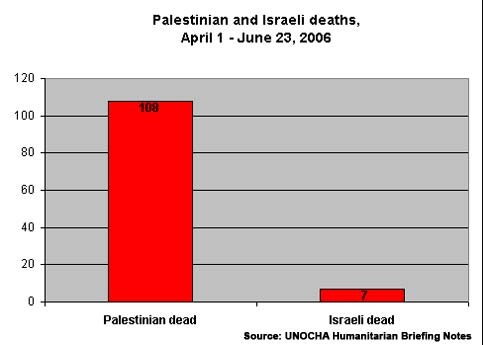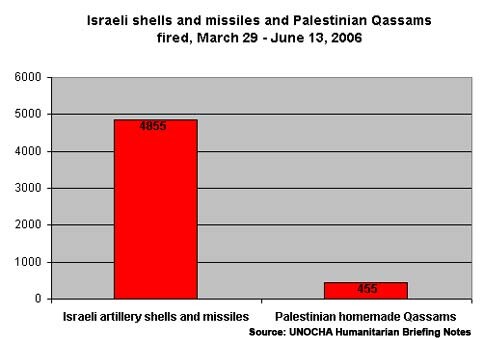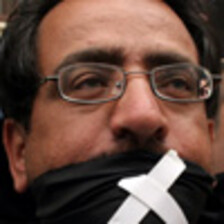The Electronic Intifada 23 June 2006

Palestinian children hold a mock trial of Israeli Army Minister Amir Peretz for his massacre of the Ghalia family on Gaza beach during a protest outside of the UN offices in the Gaza Strip. The Palestinian child who played the part of Amir Peretz was symbolically handed over to the UN representative in Gaza to be taken to the International Court and tried for his crimes, June 18, 2006. (MaanImages/Wesam Saleh)
The Israeli military’s shelling of a Gaza beach on June 9 and killing of eight Palestinian civilians focused world attention on Israel’s intensive artillery campaign against Gaza. Since then, 14 more Palestinian civilians have been killed by Israeli missiles. The US corporate media has highlighted dubious Israeli denials of responsibility for the Gaza beach killings, while providing much less space to Palestinian and third party assertions of Israeli responsibility. The privileging of the Israeli narrative fits into the general pattern of US corporate media coverage of Israel/Palestine. Indeed, a detailed examination of The New York Times, LA Times and Washington Post’s coverage of Israel’s shelling campaign against Gaza reveals that those newspapers have neglected basic facts about Israel’s aerial assault since it started on March 29, 2006.
Typically, the US corporate media has placed the Israeli missile and shellfire within a context of Israeli response to Palestinian Qassam rocket fire and to terrorism, rather than representing it as another facet of Israeli occupation. Concretely, for more than two months, all three newspapers ignored weekly UN reports showing that Israel increased its “retaliatory” shelling of Gaza more than twenty-fold beginning in early April, that Palestinian Qassam rocket attacks increased only slightly, and that Israel has since struck Gaza with at least ten powerful shells and missiles per one homemade Palestinian Qassam fired towards Israel.
On June 11, two months and 13 days into Israel’s campaign, one of the three newspapers, The New York Times, finally compared the number of Palestinian Qassams fired to the overwhelming number of Israeli shells and missiles shot, and on June 16 The New York Times became the only newspaper to compare more than 80 Palestinians killed by Israeli shelling and air strikes in Gaza in the last six months (an underestimate) to the eight Israelis killed in three years by Palestinian Qassams.
The three newspapers have largely failed to examine basic questions of proportionality of each side’s actions, and never questioned the Israeli government claim, proven false by the data, that the massive Israeli aerial assault was a response to increased Palestinian rocket fire. Together, these three newspapers have hidden reality from readers by privileging Israeli government statements about the Gaza campaign, while maintaining a veneer of balance.
Missing the Big Picture: Palestinian Terrorism vs. Israeli Occupation
All three newspapers typically frame the large-scale Israeli shelling as a response to the firing of Palestinian Qassams into Israel, with Palestinians as the aggressor. However, that ignores the realities of Palestinian life in Gaza. Gazans still experience their lives as controlled by Israeli military occupation through violence, siege, isolation and displacement. While Israeli soldiers and settlers are no longer on the ground in Gaza, Gazans are subject to on-going Israeli military attacks, the destruction of their land and property, a blockade on the movement of people, goods, aid and even money between Gaza and the West Bank, and to the rest of the world, as well as continued Israeli control of Gaza’s airspace and seacoast.
Israeli closures and restrictions at borders and crossing points severely affect all 1.4 million Gazans and 2.4 million West Bank residents daily. Since 1993 Israel has progressively restricted Palestinian movement and isolated Gaza, regardless of “calm” or violence. However, in the last seven months, stifling Israeli border restrictions with Gaza have been the subject of just one feature story each in The LA Times and Washington Post, and two feature stories in The New York Times.
While Israelis see themselves as victims of terrorism, and Qassams as one manifestation of that, Palestinians place shelling and Qassams within the context of a violent, aggressive Israeli occupation. At a minimum “balanced journalism” should present equally the Israeli and Palestinian narratives of “terrorism” and “occupation.” Instead, Palestinian terrorism remains the dominant lens.
In their news coverage from April 1 to the present, The New York Times and LA Times, and The Washington Post used the terms terrorism or terrorist to describe Palestinians 83 times, while mentioning Israeli occupation just 28 times. This emphasis on Palestinian terrorism occurred during a period in which 108 Palestinians were killed by Israelis, at least 53 of them civilians, while 7 Israeli civilians were killed by Palestinians.

Proportionality and Journalistic Balance: Omitting Statistics on Attacks and Deaths
Since it began on March 29, The New York Times, LA Times and Washington Post have generally avoided reporting publicly available information conveying the scale of Israel’s assault on Gaza. Though I can’t claim credit, The New York Times first reported the number of Israeli shells on June 10, after I sent them repeated emails.
The United Nations Office for Coordination of Humanitarian Affairs (OCHA) issues weekly “Humanitarian Briefing Notes” noting numbers of Palestinian Qassams and Israeli shells fired, and Palestinian and Israeli casualties. Compiling the data from the weekly UNOCHA reports shows that since Israel’s Gaza disengagement on September 12, 2005 until March 28, 2006, Israel fired 1161 artillery shells and surface to air missiles into Gaza while Palestinians shot 686 Qassams towards Israel. From March 29, 2006 until June 13, 2006, Israel dramatically upped its attacks, firing 4748 artillery shells and 107 missiles while Palestinians shot 455 Qassams - 10.7 Israeli strikes per Qassam fired. After March 28, Palestinians did increase the average number of Qassams they fired from 24.5 per week to 41.4 per week. However, excluding the last week, June 7-13, when 133 Qassams were fired, the increase was only from 24.5 to 32.2 Qassams per week. On the other hand Israel upped its average weekly strikes from 41.5 to 441.

Beyond these startling figures for Israeli strikes, OCHA Gaza officials explained by email that more careful review shows that the actual number of Israeli shells and missiles fired since the March 29 is 7986, 61% higher than the 4855 Israeli strikes from the weekly OCHA reports.
Despite the data’s availability, the three newspapers provided only vague information about this dramatic Israeli escalation. For example, The Washington Post on April 18 noted “an intensive military campaign.” The LA Times noted on April 8 “intensifying strikes in recent days, including naval barrages, artillery shelling, tank fire and air attacks”. Exceptionally, on April 24 The LA Times quoted human rights groups saying that Israel’s shelling was “disproportionate to the threat posed by the crude rockets, which rarely cause deaths or injuries.” On May 27, the LA Times noted Israel’s firing of “thousands of shells.”
An unusual April 12 New York Times article by John Kifner provided some facts: “Additional artillery batteries and tanks were sent in. And Israel reduced the margin of safety in which shells could be fired near civilian areas from roughly 1,000 feet to about 300 feet… the military was firing some 300 rounds a day into Gaza from cannon, tanks, warships, helicopters and drones.”
On May 2, The New York Times published a feature article by Bureau Chief Steven Erlanger about a shell-damaged home in Gaza where two children were wounded. The family recounted their trauma. Erlanger quoted an Israeli commander on the number of weekly and monthly Qassams fired by Palestinians, but gave no corresponding figures for Israeli shells. Ironically, according to UNOCHA’s weekly reports, during the 34 days prior to May 2, Israel had fired 3068 shells and missiles into Gaza, compared with 162 Qassams.
Erlanger noted overall numbers for Palestinians killed (174) and Israelis killed (34) since the September 12 Gaza disengagement, but not figures for those killed by Israeli shells and missiles and Palestinian Qassams. Since Israel’s Gaza disengagement, according to my review of B’Tselem and UNOCHA descriptions of each Palestinian killed, approximately 117 Palestinians from Gaza have been killed by Israeli shells or missiles, at least 53 of them civilians. In comparison, over the last five years, eight Israelis have been killed by Palestinian Qassams. On June 14, after I sent emails noting this, The New York Times first mentioned the eight Israelis killed by Qassams, and on June 16 The Times raised the issue of proportionality of Israeli attacks. The LA Times finally mentioned the low number of Israelis killed by Qassams on June 22, while The Washington Post still has not. The Washington Post and the LA Times have yet to mention the large numbers of Gazans killed by Israeli rockets and missiles during the last months.
No Critical Analysis of Reasons for Israeli Escalation
A review of events raises questions about why Israel escalated its shelling. The dramatic escalation in Israeli shelling of Gaza began on March 29 with a jump from an average of six Israeli shells fired per day to 86 Israeli shells fired that single day. The number shot up further to 297 shells on April 1, and peaked at 401 shells on April 7. Palestinians increased Qassams fired from two or three daily to six in one day only on April 2, and then nine on April 5. From March 29 – April 4, Palestinians fired 27 Qassam rockets at Israel, only slightly above the longstanding weekly average of 24.5. Palestinians escalated to 46 Qassams from April 5-11, but they had fired 40 or more Qassams in a week six times in the seven prior months without a massive Israeli reaction. The most significant increase in Israeli shelling occurred by April 1, before the increase to six Qassams on April 2, and to 46 Qassams the following week.
Therefore, factors beyond Palestinian rockets probably explain Israel’s aerial assault. On March 28 Kadima won Israel’s elections. On March 29 the Hamas-led Palestinian authority was sworn in, and Israel’s escalation began. On March 30, a Palestinian from Al Aqsa Brigades, an offshoot of Fateh, carried out a suicide attack within the West Bank killing four Israeli settlers. Palestinian attacks within the West Bank are typically treated even by Israel as less egregious than those within Israel. The most salient events during the period were Israeli elections and Hamas’ swearing in.
However, the three newspapers missed this. On April 8, The Washington Post explained that, “The Israeli military has stepped up artillery fire into northern Gaza in the past two days after more than a dozen rockets landed inside Israel,” but Israel had dramatically increased shelling one week before. On April 12, The New York Times reported that “Since the Hamas government took office a little over a week ago, Israeli officials say, there has been an increase in the number of homemade Qassam rockets fired.” However, Israel’s escalation preceded the slight increase in Qassams.
On April 10 the LA Times’ Laura King hinted at the most likely explanation for Israel’s escalation: “As Israel has struck an unyielding diplomatic stance against Hamas, its army has sharply stepped up attacks against Palestinian militants in the Gaza Strip.” Indeed, the Israeli shelling escalation appears most likely to be an unacknowledged component of the otherwise well reported Israeli and US effort to bring down Hamas by collectively punishing the Palestinian people.
In an April 9 article, Scott Wilson of The Washington Post quoted Palestinian Prime Minister Ismail Haniyeh to that effect, saying, “This Israeli escalation aims to bring the Palestinian people on their knees and to blackmail the government in order to win over political concessions.” On April 12, The New York Times quoted a similar Haniyeh statement. But the newspapers never went beyond hints about the political motivation behind the shelling.
The June 9 Gaza Beach Shelling
After eight Palestinian civilians were killed by an Israeli shell while picnicking on a Gaza beach, The New York Times and LA Times immediately launched into a bizarre spin mode, even while the Israeli military initially accepted responsibility for the strike. The LA Times headlined their beach shelling article with “Hamas Pledges Attacks on Israel.” They devoted much of the opening nine sentences to Hamas’ threat to retaliate by attacking Israelis, before shifting to the Palestinian civilian deaths. The New York Times used a similar headline. The opening two sentences gave as much space to Hamas’ threat as to the killing of eight Palestinians. Only The Washington Post’s headline and article focused on the Palestinian deaths. Hamas members did fire some Qassams those next days, but Hamas has largely held their truce. Two leading US newspapers had placed unfulfilled Hamas threats of retaliation higher in the story than eight Palestinian civilian deaths.
This continued as the Israeli government began to assert that the Palestinians were killed by Palestinian explosives, not by Israeli shelling. Researchers in Gaza from Human Rights Watch, a third party, quickly provided strong counter-evidence casting serious doubt on Israeli denials. Nonetheless, since the story broke on June 10, the LA Times has devoted 799 words to the Israeli government position, but only 179 words to Palestinian Authority positions and 195 words to Human Rights Watch’s assertions. The New York Times reported 1473 words on Israeli positions, only 274 words on Palestinian positions, and just 216 words of Human Rights Watch criticisms of Israel’s investigation. While fairness might suggest equal space for the Israeli and Palestinian positions, only The Washington Post has nearly balanced 580 words on Israeli government positions with 213 words from Palestinians and 349 words from Human Rights Watch. Shamefully, only 82 words of accounts from Palestinians eyewitnesses have been published by these newspapers.
The Gaza beach shelling provides yet one more example of the Israeli narrative’s dominance in US corporate media. If basic principles like presenting facts and both sides of the story matter, then the US’ leading newspapers are failing the US public on Israel/Palestine. Most American newspaper readers wouldn’t have learned of the thousands of shells and missiles Israel has fired into Gaza, or the vast disparity in Palestinians killed relative to Israelis by missiles and rockets. These newspapers never told readers that Israel likely escalated its assault on Gaza as part of the campaign to overthrow the democratically elected, Hamas-led Palestinian Authority, nor that this assault is just one component of Israel’s 39 year occupation.
Based on the record of these papers, Americans simply shouldn’t expect balanced reporting on Israel/Palestine from US corporate media outlets like The New York Times, the LA Times and The Washington Post. We need to seek accurate information elsewhere, even as we write to the editors and reporters at these newspapers and demand change.
Patrick O’Connor is an activist with Palestine Media Watch and the International Solidarity Movement. He is conducting a research project on the major US newspapers’ coverage of Israel/Palestine.
Related Links




